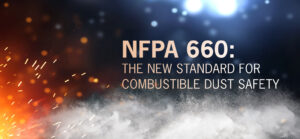Camfil Air Pollution Control collaborated with a major auto parts manufacturer utilizing dust collectors to maintain healthy air in robotic weld cells. They successfully cut downtime for dust collector maintenance.
The facility operators thought they possessed the best system possible because the vendor presented them with complex computational fluid dynamics data of airflow performance. The vendor’s aim was to demonstrate systems built according to this particular design would effectively prevent fires.
However, the reality was different. The dust collection systems implemented led to significant downtime, costly maintenance, and even fires within the collectors themselves.
Fire, Filter and Fan Frustrations
The company faced recurring issues with its dust collectors, causing significant downtime. When dust collectors caught fire multiple times, part production lines were halted for days. When differential pressure built up in the dust collectors, the systems’ fans would engage, meaning the filters could not be pulse cleaned during this time. Consequently, staff had to shut off the collectors to clean the filters manually during lunch and break times, causing at least two hours of downtime each day. Moreover, the filters needed to be replaced every six months, adding to the time and operation costs.
The noise generated by the collectors’ fans also posed a problem, leading to complaints from neighbors. Additionally, the fans within the collector housing were prone to overheating, necessitating the costly replacement of multiple 50-horsepower motors each year. And accessing the fans for maintenance was difficult, especially during the winter season because the collectors were located outdoors.
Welding Dust and Fume Experts
Facility managers recognized the urgent need for a reliable dust collector partner guaranteeing the seamless operation of their manufacturing lines around the clock. Camfil APC’s Wayne Zimmer responded by bringing a Gold Series dust collector demo trailer to the site to present firsthand the user-friendly maintenance and filter removal features.
Ultimately, Camfil APC provided a new Gold Series dust collector system with a completely different ductwork design for the weld cells. This system enables facility operators to safely return filtered air back into the plant using integrated safety monitoring filters.
Thanks to the efficiency of the new system, the manufacturer hasn’t purchased new filters for over three years. Additionally, there have been no fires in the collector or extra maintenance needed for the fans or electrical system. Impressed by these outcomes, the company decided to install two more dust collection systems from Camfil APC.
Watch the Full Switching Story
To get the full story, watch Zimmer in this Preventing Downtime for Filter Cleaning video.
Dangerous Airborne Particles in Welding Operations
Welding and cutting activities, whether manual or robotic, emit harmful fumes (minute airborne dust particles) contaminating workshop air and posing health and safety risks to workers. Processes like arc gouging, plasma cutting and laser cutting produce these fumes, and the level of fumes generated rises with production levels.
The most effective approach to minimize exposure to hazardous metalworking fumes is by installing well designed dust collection systems equipped with high-efficiency primary cartridge-style filters. In some cases, secondary safety filters may be necessary to capture certain particulates.
Important Safety and Health Regulations
As is the case with this auto parts manufacturing facility after installing customized Camfil APC systems, welding operations can often recirculate the cleaned air back into the workspace. However, the reintroduced air must stay below OSHA permissible exposure limit (PEL) thresholds for metal contaminants generated from welding processes. Shops exhausting the air outdoors must also comply with EPA emission requirements.
OSHA PELs are based on an eight-hour time-weighted average (TWA) for metals found in welding fumes. These requirements determine the minimum filtration efficiency needed for dust collectors. Despite the air meeting PELs in a facility, some workers may still face health issues from fumes. In such cases, exposure limits may need further reduction to ensure safe indoor air quality.
The EPA’s National Emission Standards for Hazardous Air Pollutants (NESHAP) Rule 6X regulates facilities that vent contaminated air directly outdoors. The standard covers hazardous air pollutants from metal finishing such as cadmium, chromium, lead, nickel and manganese.
Cartridge filtration is recognized in Rule 6X as an acceptable control device to eliminate visible emissions. Installing dust and fume collectors with high-efficiency cartridge filtration systems like Camfil APC Gold Series industrial dust collectors aids welding facilities in maintaining EPA compliance.
Click here to discover more solutions to mitigate airborne particles in welding operations.
 Americas
Americas 




